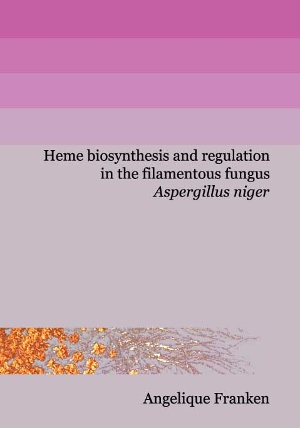Proefschrift
Heme biosynthesis and regulation in the filamentous fungus Aspergillus niger
Promotors: Prof.dr. P.J. Punt, Prof.dr. C.A.M.J.J. van den Hondel
- Auteur
- A.C.W. Franken
- Datum
- 17 december 2013
- Links
- Thesis in Leiden Repository

Cellulose makes up one of the most abundant renewable materials, present in all kinds of plant biomass (Pauly and Keegstra 2010). However, to be able to utilize the cellulose as feedstock, it needs to be separated from lignin which cements the cellulose and hemi-cellulose fibers. Lignolytic peroxidases can be produced by Aspergillus niger, and its production was found to be improved by heme supplementation, suggesting a limiting effect of this co-factor during heterologous expression. The research described in this thesis explores fungal heme biosynthesis and its regulation by means of heme deficient mutant strains and overexpression strains of heme biosynthesis genes or corroborated iron metabolism with the final aim to increase the available intracellular heme for peroxidase production. Using heme deficient strains, we demonstrated that A. niger is capable of heme uptake and utilzation and that siroheme synthesis derives from the first half of the heme biosynthesis pathway as well. The tight regulation on heme biosynthesis on transcription and (post)translational level prohibits large changes in heme content, and indicated a bottleneck on the level of ferrochelatase and possible uroporphyrinogen III decarboxylase and coproporphyrinogen III oxidase and questions whether A. niger would be the most suitable host for heterologous peroxidase production.
